Interactive Video Vignettes (IVVs) to Help Students Learn Genetics Concepts
Editor: Jennifer Knight
Published online:
Abstract
Many video resources exist to teach Mendelian genetics, but most consist of passive delivery of information rather than active construction of knowledge by users. We have created two interactive video vignettes (IVVs) that can be used together or separately to introduce students to core concepts of genetics, using principles of active learning (e.g., elicit-confront-resolve, directed feedback, reflection). These online resources are free and can be assigned as homework for students to complete outside of class. Each IVV features a realistic scenario of undergraduate students investigating genetic phenomena by collecting and analyzing data. During the IVVs, the user is integrated into the process, answers conceptual questions, receives feedback based on their answers, and reflects on the experience by comparing their original ideas to their new understandings. Marfamily is primarily designed to teach pedigree construction and analysis, while A Matter of Taste addresses common misconceptions about dominance. Both also demonstrate the scientific method. Users cannot advance without answering the questions, although they can review past scenes. Resources for both formative and summative assessment are provided. The IVV is easily integrated into any course where an introduction to or review of basic genetics is needed.
Citation
Newman DL, Cardinale JA, Wright LK. 2020. Interactive Video Vignettes (IVVs) to help students learn genetics concepts. CourseSource. https://doi.org/10.24918/cs.2020.27
Society Learning Goals
Genetics
- Transmission - Patterns of Inheritance
- How can one deduce information about genes, alleles, and gene functions from analysis of genetic crosses and patterns of inheritance?
Science Process Skills
- Process of Science
- Interpret, evaluate, and draw conclusions from data
- Construct explanations and make evidence-based arguments about the natural world
- Modeling/ Developing and Using Models
- Recognize the important roles that scientific models, of many different types (conceptual, mathematical, physical, etc.), play in predicting and communicating biological phenomena
- Make inferences and solve problems using models and simulations
- Build and evaluate models of biological systems
- Quantitative Reasoning/ Using Mathematics and Computational Thinking
- Apply the tools of graphing, statistics, and data science to analyze biological data
Lesson Learning Goals
Students will be able to:
- describe the relationships between genes, alleles, proteins, and traits.
- construct and analyze pedigrees for Mendelian traits.
- conceptualize the link between genotype and phenotype.
- estimate risk of inheritance using pedigree data.
- correctly interpret and use the terms "dominant" and "recessive."
Lesson Learning Objectives
Learning Objectives that align with the Marfamily IVV
- Define the term "trait" in terms of genetic and environmental influences.
- Recognize that negative traits/disorders can be encoded by dominant alleles.
- Correctly interpret a pedigree.
- Determine the probability of inheritance of a single gene, autosomal trait.
- Use both phenotype and relationship data to assign genotypes within a family.
Learning Ojectives that align with the Matter of Taste IVV
- Describe the relationships between a gene and its alleles.
- Describe potential relationships between alleles of the same gene.
- Explain how each allele for a gene contributes to the organism's phenotype.
- Describe dominance purely as the allele whose associated phenotype is observed regardless of the sequence of the second allele.
- Calculate allele frequency using the Hardy-Weinberg equations.
Article Context
Course
Article Type
Course Level
Bloom's Cognitive Level
Vision and Change Core Competencies
Vision and Change Core Concepts
Class Type
Class Size
Audience
Lesson Length
Pedagogical Approaches
Principles of How People Learn
Assessment Type
INTRODUCTION
Interactive Video Vignettes are short, online videos that employ live-action and interactive features that allow users to make predictions, analyze data, and reflect on what they learned (1). Users watch as a live-action, realistic and relatable scenario unfolds, while responding to questions along the way. The videos employ a conversational style that has been shown to help students connect and buy into the scenario (2). Navigation through the story may involve branching to different scenes depending on the user's answers, and individual pages of IVVs utilize different types of questions, data collection tools, and layouts. Storylines for the IVVs involve undergraduate students (actors) trying to make sense of a biological phenomenon, such as differential gene expression or genetic inheritance. The IVVs align with the Vision and Change core concepts and competencies as well as other national standards (3-5) and are designed as out-of-class priming activities (https://www.rit.edu/cos/interactive/MINT/ivv-list.php). IVVs include many instructional practices that promote deep understanding and include principles of cognitive learning theories such as elicit-confront-resolve (6) and constructivism (7,8) to support learning of core concepts.
A growing number of instructors are using the flipped classroom model or teaching online courses, and the outcomes have generally been positive (9,10). Students enjoy watching videos as class preparation and prefer them to reading assignments (11). As a result, many videos have been developed for students to watch outside of class, but few of these videos incorporate active learning principles. Typical videos simply move the passive part of the course (often a lecture) to homework. IVVs on the other hand, make the homework interactive as well.
Each of the IVVs was developed using a backwards-design approach (12), in which learning objectives and assessment choices were aligned and used to inform the ideas presented in the IVVs. In this paper we describe two IVVs (Marfamily, https://www.rit.edu/cos/interactive/MF/2/v/index.php and A Matter of Taste, https://www.rit.edu/cos/interactive/TT/2/v/index.php) that can be used to help students learn important concepts in genetics. The IVVs are meant to be used as out-of-class priming activities to help students prepare for in-class activities and discussion about the topic. The IVVs are purposely not tied to any particular in-class activity or lesson; they were designed so that instructors could easily incorporate them into their normal curriculum.
In the Marfamily IVV, a college student video chats with his mother, who tells him about a cousin who has passed away as the result of Marfan Syndrome. As the pair learn about Marfan Syndrome, they become concerned that the student may also be affected. The student explains genetic inheritance to his mother, and together they piece together a pedigree that they analyze with respect to the disease. This IVV is ideal for an introductory biology student who is beginning a genetics unit or a student at the beginning of a genetics course. In the IVV terms such as "inherited disease" and "pedigree" are broken down and explained to the user.
In the IVV entitled, A Matter of Taste, (Figure 1) two students struggle to define dominance while studying genetics. They explore an example, PTC taster vs. non-taster phenotypes, and collect data in a science fair setting. The molecular reasons for the dominance relationship between alleles is discussed, and the common assumptions that dominant alleles are better, stronger, or more common are debunked. Users observe actual data showing the frequency of tasters and non-tasters. Users later reflect on their initial definition of the term "dominant" and are challenged to write a more accurate and molecular-based description. This IVV is ideal for students who have already completed the Marfamily IVV since this IVV aims to go deeper into molecular-level reasoning about the relationships between genes, alleles, and traits.
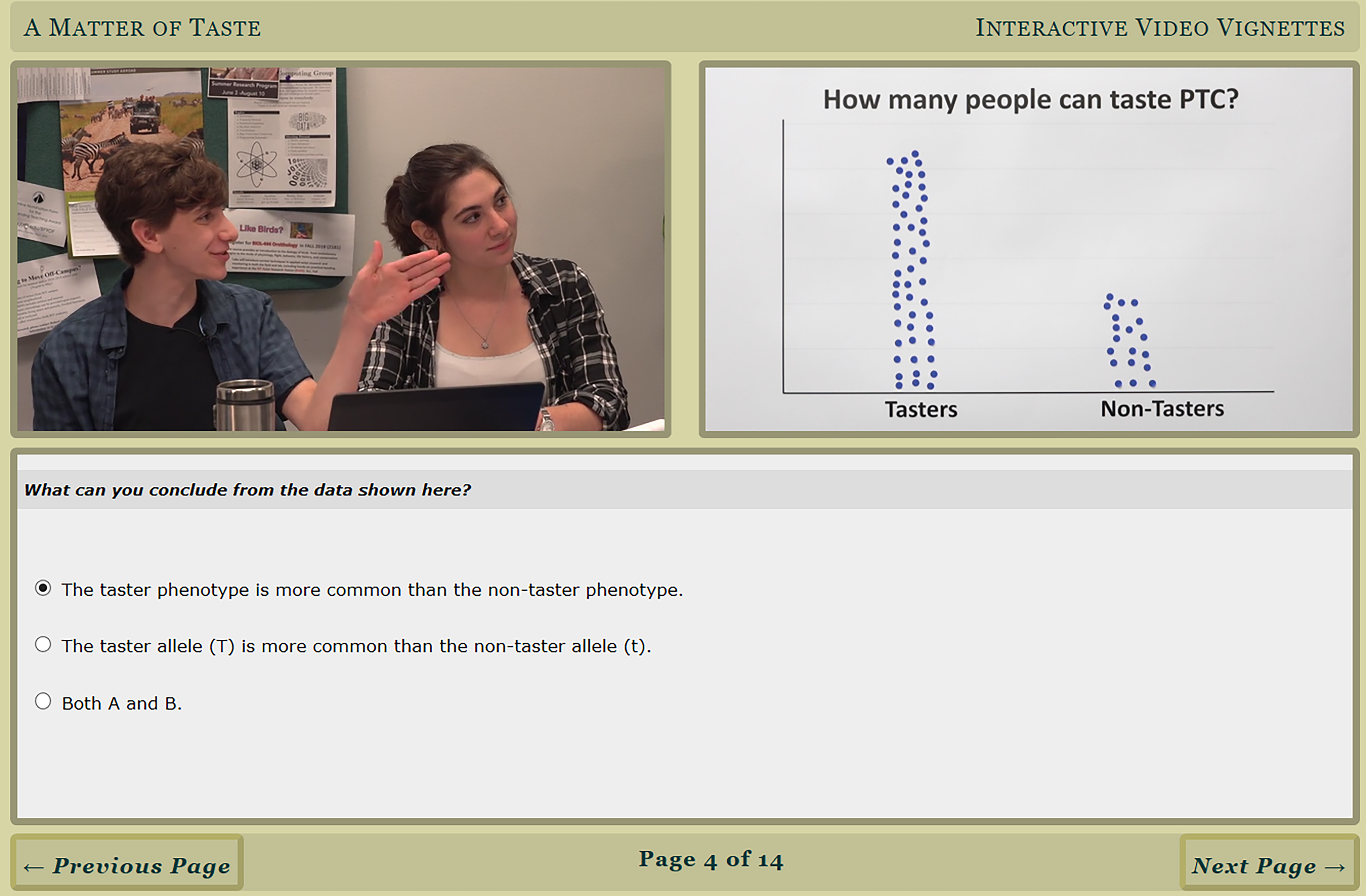
Figure 1. Screenshot of A Matter of Taste IVV. In this image the narrators/actors are directing the user to look at data that was collected during a science fair showing the breakdown between PTC tasters and non-tasters. Users are asked to answer the question.
Intended Audience
The IVVs are intended for introductory biology or introductory genetics courses. We have used them in the genetics unit of general (majors and nonmajors) and introductory (majors) biology courses, in an introductory human genetics course (nonmajors), and in an intermediate-level genetics course (majors). About half the students were enrolled at a small, private M1 (larger Master's Colleges and Universities) university (n=337); a few were at a small, private engineering-focused school (n=18), and the remainder were at a large, private R2 university (Doctoral University, High research activity) (n=276). Our classes ranged in size from 10 to 120 students; because the lessons are online, any class size may be accommodated.
Required Learning Time
Each IVV is meant to be given to students to complete as an out-of-class homework assignment. The Marfamily IVV takes about 30 minutes to complete and the Matter of Taste IVV takes about 20 minutes to complete. It may take some students longer, especially if they spend a lot of time thinking about the answers to embedded questions or replay parts of the video.
Prerequisite Student Knowledge
The IVVs were designed with the novice life science student in mind but can also be used as a review for upper level students. For an introductory biology course, we suggest using one or both of the IVVs during the unit on Genetics/Inheritance, which usually comes after topics related to the Central Dogma and cell division. Introductory biology students should have a general understanding of gene expression, including the relationship between genes and proteins before attempting the IVVs. In an introductory course, we recommend that students complete the Marfamily IVV first, as it presents inheritance at the level of the family. They should complete A Matter of Taste second, as it presents inheritance at the more sophisticated level of genes and proteins. For students in a Genetics course, we suggest assigning the IVVs relatively early, as an opportunity to review important concepts and set up for a more in-depth look at the underlying molecular mechanisms that drive inheritance.
Prerequisite Teacher Knowledge
We strongly recommend that instructors complete each of the IVVs before assigning them to their class so they are familiar with the scenarios and content. Instructors should be familiar with basic concepts in genetics, information flow, and structure/function relationships. The Marfamily IVV centers around a genetic connective tissue disease called Marfan syndrome, which is typically inherited in an autosomal dominant pattern. Instructors do not need any specific knowledge of the disease, but they should have basic knowledge about modes of inheritance, dominant versus recessive alleles, and pedigree analysis. For instructors who wish to know more about the genetics and/or molecular mechanism of Marfan syndrome, we recommend this review (13) or the OMIM entry (https://omim.org/entry/154700). It should be noted that the scenario in the IVV focuses on a case of familial, autosomal dominant inheritance. There are sporadic cases in real life, and rare recessive mutations have been reported; however, such cases are beyond the scope of the lesson.
For the A Matter of Taste IVV, instructors should have basic knowledge about structure/function relationships, the molecular basis of dominance relationships, and basic principles of population genetics (e.g., Hardy-Weinberg equilibrium). Equations are provided (and explained) in the IVV. For instructors who wish to learn more about the PTC tasting genotypes and phenotypes, we recommend this article (14) or the OMIM entry (https://omim.org/entry/171200). It should be noted that the scenario in the IVV focuses on the two most common alleles only.
SCIENTIFIC TEACHING THEMES
Active Learning
The Interactive Video Vignettes (IVVs) promote "learning while doing" by engaging learners with real-world problems and providing scaffolded support, reflection on their own learning processes, and feedback as learners progress (15). Specifically, students are asked to make predictions before the full story unfolds, answer numerous embedded questions (multiple choice, multiple select, open response) and reflect on their own learning at the end of the video segment. Instructors may wish to encourage students to work on the IVVs in pairs, which would allow for a natural dialogue where they could practice their scientific reasoning skills.
Assessment
A short multiple select assessment was developed for each of the IVVs described in this lesson. The multiple select format greatly reduces students' abilities to "game play" and select correct answers based on test-taking strategies rather than content knowledge and reveals when they hold mixed or partial understanding of concepts (16-18). All answer choices (both correct and incorrect options) have been mapped to the Learning Objectives (Table 1), and the pre/post assessments are available as supplemental files for instructors who are interested in using them (S1. Interactive Video Vignettes – Marfamily Assessment Questions and and Supporting File S2. Interactive Video Vignettes – A Matter of Taste Assessment Questions).
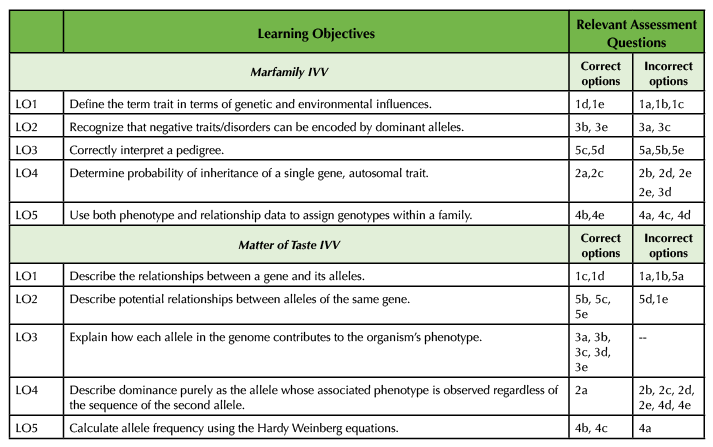
Table 1. Learning Objectives for the Marfamily and Matter of Taste IVVs aligned with relevant assessment questions.
Inclusive Teaching
The IVVs were designed using principles of Universal Design (19) to support all learners. For example, participating in in-class active learning activities may be stressful for students with anxiety or who have other learning issues. The IVVs allow students to participate in active learning (making predictions, explaining reasoning, etc.) in the privacy and comfort of their own space. Students can re-watch all or some of the video pages, slow down the video speed, and/or use the close caption feature to support their learning at their own pace. These features may be especially useful for students who are deaf/hard of hearing or who are English Language Learners. In addition, this format is especially convenient for online or blended courses.
LESSON PLAN
These IVVs are designed to be given as out-of-class homework assignments and can be easily integrated into any course where an introduction to or review of basic genetics is needed. The IVVs are meant to be priming activities to get the students ready to learn more about a particular topic. They are not meant to be the only lessons on the complex topics of genetics and information flow and should be followed-up with in-class discussions and activities.
The first page of each IVV asks students to enter in their name, so that the program can generate a personalized completion certificate for each student; the IVV team does not otherwise use this information.
We recommend that instructors use the following practices to encourage participation and buy-in from their students:
- Introduce the idea of IVVs in an enthusiastic manner and explain that IVVs are an interactive online tool that will help them learn important concepts and prepare for "what's next" in class.
- Set clear completion deadlines and provide reminders about the assignments.
- Remind students to not "multi-task" during the IVV, as they will be expected to answer embedded questions during the video.
- Ask students to print out or upload an image of the last "completion certificate" page of the IVV so that completion or participation credit can be awarded. This practice encourages students to take the assignment seriously and complete it.
- Remind students that their time spent will be visible on the completion page, so if the minimum time requirement is not met, points will not be awarded.
- Tell students not to use their browser button to back up (if they want to re-watch a page) as that may restart the video. Users should use the "previous page" button within the IVV window.
- Review students' responses to the open-ended reflection questions (on the printed completion page) to understand what students learned from the video. Instructors may uncover interesting insights or misconceptions held by their students. They may wish to respond individually to students who write incorrect/inappropriate statements in their reflections, and/or bring some of their common ideas to class to discuss further.
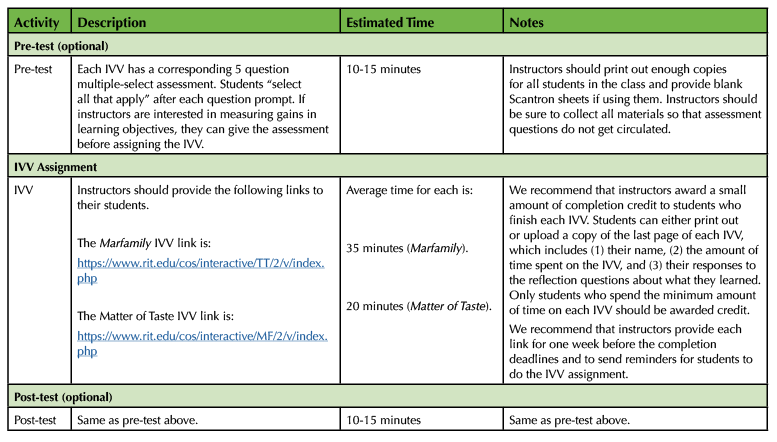
Table 2. Interactive video vignettes timeline for lesson plan.
TEACHING DISCUSSION
Human Subjects Review
IRB approval was obtained from each participating institution prior to the commencement of research protocols at each institution.
Effectiveness of the IVVs on Student Learning
We measured effectiveness of the IVVs on student learning in several ways. Although we were not able to collect pre/post assessment data from all courses that used the IVVs, we did have data from certain courses. We analyzed pre/post assessment data from honors-level biology students that were assigned the Marfamily IVV (n=24) and calculated learning gains for each Learning Objectives (Figure 2). Since each Learning Objective aligned with both correct and incorrect choices, we calculated what percentage of choices each student answered appropriately. For example, a student would get a score of 100% on LO1 for selecting answer choices 1d and 1e while also not selecting 1a, 1b and 1c, whereas a student would get a score of 80% if they selected 1a, 1d and 1e (1a incorrectly selected) or 1d alone (1e incorrectly omitted). As demonstrated in Figure 2a, students make learning gains on all five of the LOs aligned with the Marfamily IVV. We also analyzed pre/post assessment data from a 300-level Genetics course where students were assigned A Matter of Taste (n=24). Figure 2b shows that they made gains on all five of the aligned LOs.
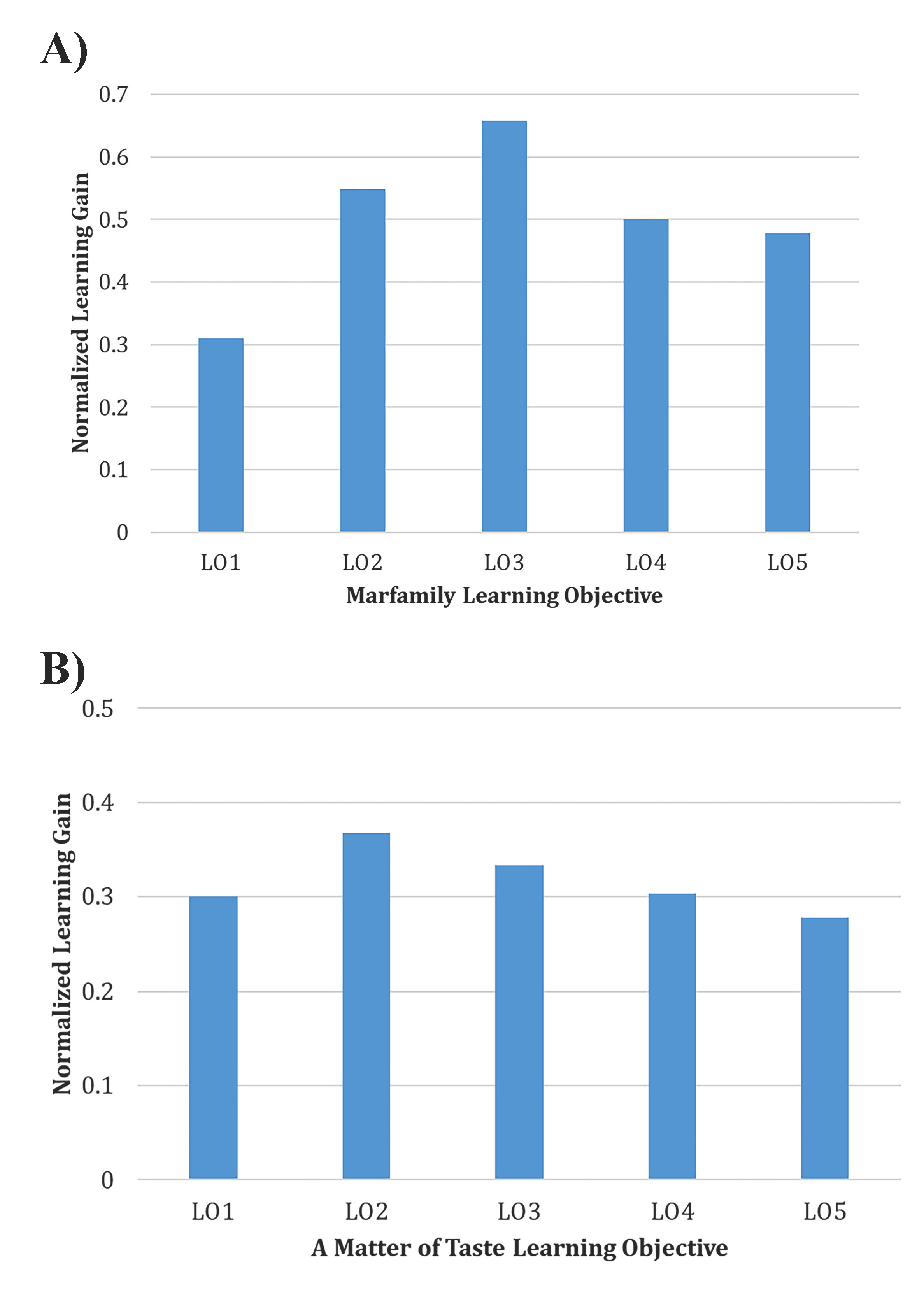
Figure 2. Students make gains on the learning objectives associated with the IVVs. Mean normalized learning gains were calculated for pre/post-test comparison on multiple-select assessment questions [LG = (post – pre)/(1-pre)]. A) Students in an honors-level introductory biology class (n= 20) made learning gains with Marfamily. The topic was not discussed in class. B) Students in a Genetics class (n=24) made learning gains with A Matter of Taste.
Introductory Biology students (n=54) were also assigned the A Matter of Taste IVV to complete but were not given the pre/post assessment. We did, however, analyze their responses to two embedded questions within the IVV. On the first page of the IVV, users were asked to respond to the question, "In genetics, what does the term 'dominant' mean?" During the IVV the molecular reasons for the dominance relationship between alleles is discussed, and the common assumptions that dominant alleles are better, stronger, or more common are debunked with the user. At the end of the IVV, the users were presented with the following:
Here is your original definition of the term "dominant": [user's original definition was here]
Do you still agree with what you wrote, or can you change it to make it more accurate? Please respond here, using the terms DNA, sequence, allele, and protein:
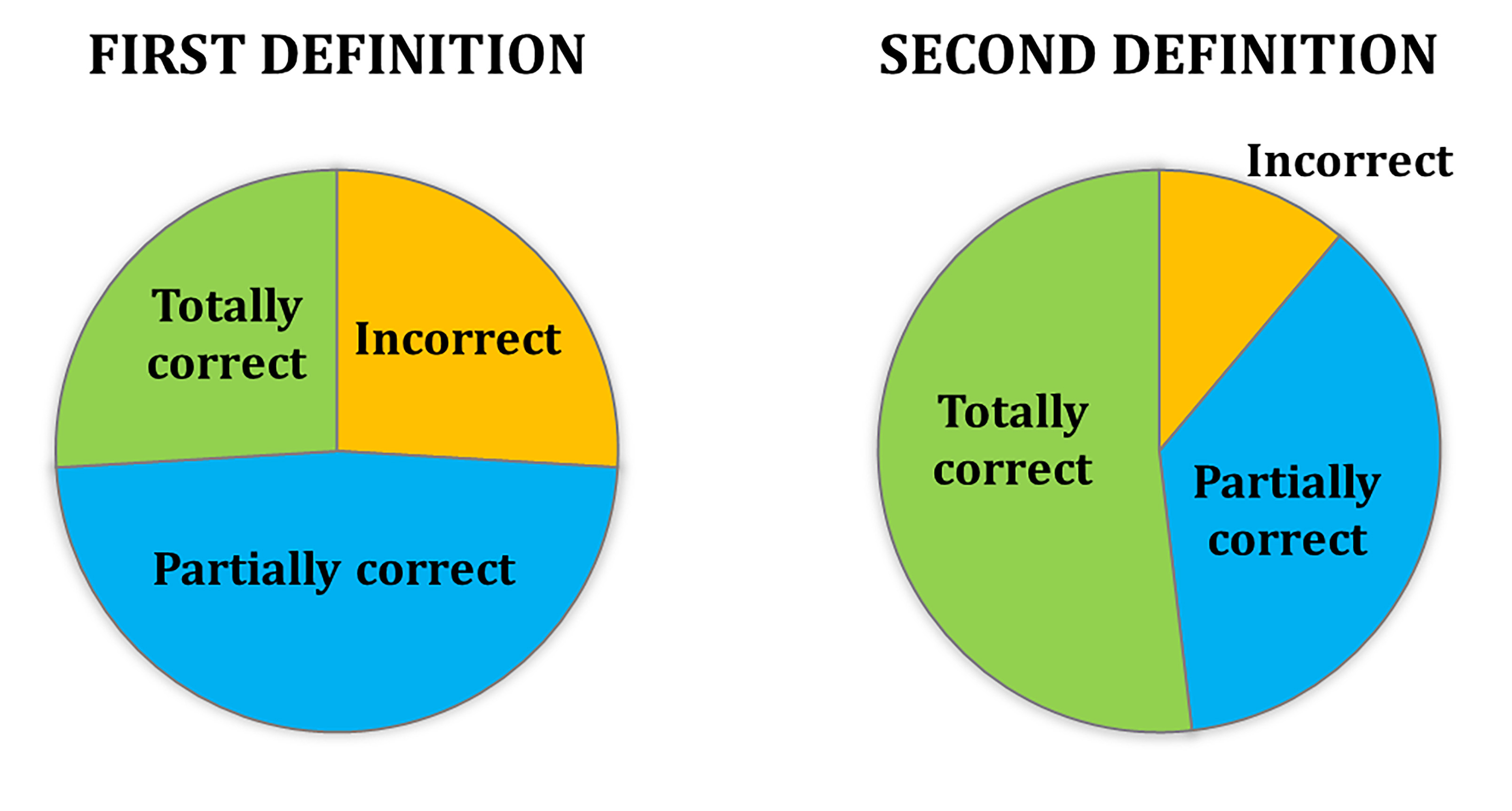
Figure 3. Student definitions of the term “dominant” improved after watching the IVV. The first time students defined the term dominance (First definition) they were scored as totally correct (26%), partially correct (48%), or incorrect (26%). After students completed the IVV and had the chance to re-write their definitions (Second definition), 52% of students wrote totally correct definitions, 35% were partially correct, and only 11% of students wrote incorrect definitions (n=54).
We analyzed the pre and post responses from students and found that students improved significantly in writing accurate definitions (χ2 test, p<0.001; Figure 3). Examples of how students improved are included in Table 3.

Table 3. Changes in student open responses to a question asking them to define “dominant” at the beginning and end of the A Matter of Taste IVV.
Student Reactions to IVVs
In our experience students enjoy the IVV assignments and find them valuable. The only negative comments we have received related to the acting skills of some actors but did not pertain to the story or content. We asked students in the introductory biology class for feedback about the IVVs and share two examples:
I look forward to doing the IVVs every week because they are fun. The storylines make them a more personal and engaging way to learn, and also allow me to remember the information from the IVVs much more than I would just reading it out of a textbook. The IVVs are an effective and entertaining way to present new information.
The IVV's we used in class really helped my understanding of material we were going over in class. They were easy to understand and learn from. Because they were interactive, they kept my attention and developed each idea steadily until I was able to state what I had learned at the end of each IVV. In addition, they were also relatively short and straightforward so that they were not time consuming. This helped keep them from losing my attention. They felt easier than homework I have had from other classes even though they had about the same amount of information because they presented the information in a condensed and focused way.
We again emphasize that instructors should remind their students to pay attention and not multi-task during the IVV assignment, or else they will not be prepared to answer the embedded questions. In our experience, if students are not aware of the interactive nature of the IVVs (and assume the assignment is a passive video), they will not get the full benefit from the first IVV they complete. Anecdotally, students pay much more attention to the second IVV assignment because they know what to expect from the software. Being explicit with students up front mitigates that learning curve.
Additional Considerations for Implementation
We intend the two genetics-themed IVVs to be used as priming activities; in other words, after students have completed each IVV outside of class, the instructor uses the in-class time to build off of the important ideas during class activities and discussion. When we implemented the IVVs for testing, we made a decision not to discuss the content of the IVVs in subsequent classes so that we could measure student learning that was linked to the IVVs without the confounding factors of in-class lessons or discussions. From a research perspective, this strategy made sense as it allowed us to (1) focus on learning that happened from the IVVs and (2) uncover areas that students had confusion about after they completed the two IVVs. Thus, we are able to present that information here so that instructors know what to expect and have ideas on how to help students overcome these misconceptions or areas of confusion. We do not recommend that instructors follow our example of not following up on the content in class. The IVVs should be a beginning, not an end, to discussing the topics. Below are some suggestions for follow-up.
Marfamily
This IVV is particularly useful for introducing students to drawing and interpreting pedigrees. It hits on many vocabulary terms and principles that are core to genetics, such as "allele," "dominant," and inheritance patterns. However, only a single example is shown, and this is a dominant disorder. Therefore, it would be appropriate to follow up with other examples of different modes of inheritance (autosomal recessive, X-linked, etc.) and ask students to compare and contrast the patterns that they notice (e.g., is one sex affected more than the other, does the trait seem to skip generations, what percentage of offspring are affected). Furthermore, the risk assessment in the IVV is qualitative rather than quantitative, and an in-class activity might move to calculating probabilities.
A Matter of Taste
We find that this IVV is effective at getting students to start thinking about alleles on a molecular level. Students are presented with one mechanism that explains the recessive nature of the non-taster allele. They learn the concept of loss of function and why loss-of-function alleles tend to be recessive. However, this can lead to a new misconception—that all recessive alleles follow this same pattern (recessive = non-functional version of the protein), when in reality, there are numerous ways in which an allele may be recessive. We suggest that instructors follow up the IVV with a discussion of other ways to explain dominance relationships. For example, an instructor could pose the question, "What would happen if the rate of transcription of a particular allele was really low?" Alternatively, they could ask students to predict actual changes in the gene structure to explain various outcomes (e.g., a change in the promoter sequence may not favor transcription factor or RNA polymerase binding). Other topics could include gain-of-function versus loss-of-function alleles, functional differences between dominant and recessive alleles, and pleiotropy.
SUPPORTING MATERIALS
- S1. Interactive Video Vignettes – Marfamily Assessment Questions
- S2. Interactive Video Vignettes – A Matter of Family Assessment Questions
ACKNOWLEDGMENTS
This work was supported by NSF DUE 1432286 and 1432303. The authors wish to thank Dr. Robert Teese for designing the IVV software and for directing and editing the videos. The authors also thank the instructors who implemented the IVVs in their classrooms.
References
- Wright LK, Newman DL, Cardinale J, Teese R. 2016. Web-based Interactive Video Vignettes Create a Personalized Active Learning Classroom for Introducing Big Ideas in Introductory Biology. Bioscene 42:32-43.
- Mayer RE. 2008. Applying the Science of Learning: Evidence-Based Principles for the Design of Multimedia Instruction. American Psychologist 63:760-69.
- AAAS. 2011. Vision and Change in Undergraduate Biology Education: A Call to Action. Final Report of a National Conference Organized by the AAAS with support from NSF, American Association for the Advancement of Science, Washington, D.C.
- Brownell SE, Freeman S, Wenderoth MP, Crowe AJ, Wood WB. 2014. BioCore Guide: A Tool for Interpreting the Core Concepts of Vision and Change for Biology Majors. LSE 13:200-211.
- NGSS Lead States. 2013. Next Generation Science Standards: For States, By States. The National Academies Press, Washington, D.C.
- Scherr RE. 2007. Modeling student thinking: An example from special relativity. American Journal of Physics 75:272-280.
- Baviskar SN, Hartle RT, Whitney T. 2009. Essential Criteria to Characterize Constructivist Teaching: Derived from a Review of the Literature and Applied to Five Constructivist-Teaching Method Articles. International Journal of Science Education 31:541-550.
- Travis H, Lord T. 2004. Traditional and Constructivist Teaching Techniques: Comparing Two Groups of Undergraduate Nonscience Majors in a Biology Lab. Journal of College Science Teaching 34:12-18.
- Gross D, Pietri ES, Anderson G, Moyano-Camihort K, Graham MJ. 2015. Increased Preclass Preparation Underlies Student Outcome Improvement in the Flipped Classroom. LSE 14:ar36.
- Herreid CF, Schiller NA. 2013. Case Studies and the Flipped Classroom. Journal of College Science Teaching 42:62-66.
- Long T, Logan J, Waugh M. 2016. Students' Perceptions of the Value of Using Videos as a Pre-class Learning Experience in the Flipped Classroom. TechTrends 60:245-252.
- Wiggins GP, McTighe JA. 2005. Understanding By Design. Assn. for Supervision & Curriculum Development, Alexandria, VA.
- Pepe G, Giusti B, Sticchi E, Abbate R, Gensini GF, Nistri S. 2016. Marfan Syndrome: Current Perspectives. Appl Clin Genet 9:55-65.
- Wooding S, Kim U, Bamshad MJ, Larsen J, Jorde LB, Drayna D. 2004. Natural Selection and Molecular Evolution in PTC, a Bitter-Taste Receptor Gene. The American Journal of Human Genetics 74:637-646.
- Bransford JD, Brown AL, Cocking RR. 2001. How People Learn: Brain, Mind, Experience, and School, p. 57-86. In Early Childhood Development and Learning: New Knowledge for Policy. National Academy Press, Washington, D.C.
- Couch BA, Hubbard JK, Brassil CE. 2018. Multiple-True-False Questions Reveal the Limits of the Multiple-Choice Format for Detecting Students with Incomplete Understandings. BioScience 68:455-463.
- Brassil CE, Couch BA. 2019. Multiple-True-False Questions Reveal More Thoroughly the Complexity of Student Thinking than Multiple-Choice Questions: A Bayesian Item Response Model Comparison. International Journal of STEM Education 6:16.
- Newman DL, Snyder CW, Fisk JN, Wright LK. 2016. Development of the Central Dogma Concept Inventory (CDCI) Assessment Tool. CBE Life Sci Educ 15:ar9.
- Scott SS, McGuire JM, Foley TE. 2003. Universal Design for Instruction: A Framework for Anticipating and Responding to Disability and Other Diverse Learning Needs in the College Classroom. Equity & Excellence in Education 36:40-49.
Article Files
Login to access supporting documents
Interactive Video Vignettes (IVVs) to Help Students Learn Genetics Concepts(PDF | 480 KB)
S1. Interactive Video Vignettes-Marfamily Assessment Questions.docx(DOCX | 51 KB)
S2. Interactive Video Vignettes-A Matter of Taste Assessment Questions.docx(DOCX | 19 KB)
- License terms

Comments
Comments
0 Like
Stefanie West Leacock @ on
It looks like the link is no longer active. Is there a new home for the Marfan video? It was so wonderful to share with Genetics students.
Copy link Report abuse